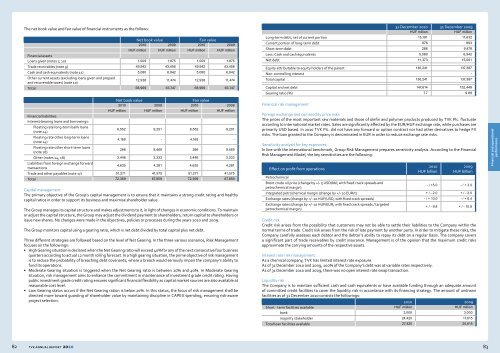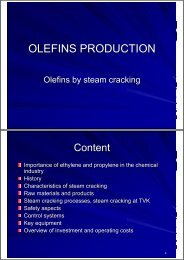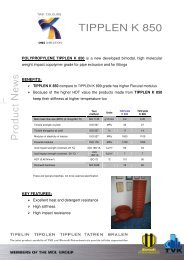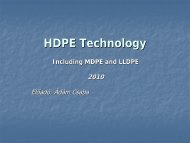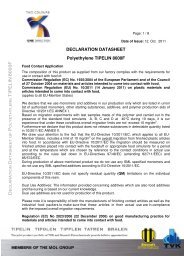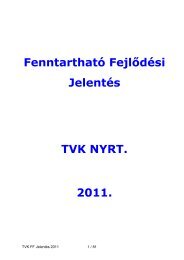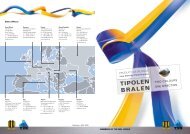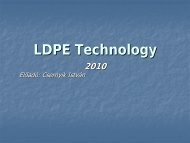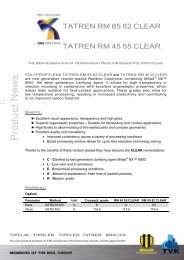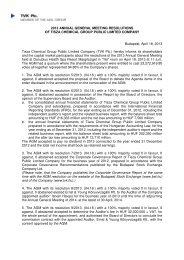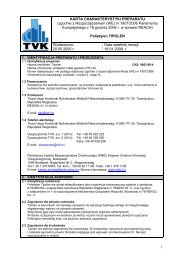TVK Annual Report 2010 (pdf, 2.5 MB)
TVK Annual Report 2010 (pdf, 2.5 MB)
TVK Annual Report 2010 (pdf, 2.5 MB)
You also want an ePaper? Increase the reach of your titles
YUMPU automatically turns print PDFs into web optimized ePapers that Google loves.
The net book value and fair value of financial instruments as the follows:<br />
Net book value<br />
Fair value<br />
<strong>2010</strong> 2009 <strong>2010</strong> 2009<br />
HUF million HUF million HUF million HUF million<br />
Financial assets<br />
Loans given (notes 7, 10) 1,009 1,875 1,009 1,875<br />
Trade receivables (note 9) 49,942 43,456 49,942 43,456<br />
Cash and cash equivalents (note 11) 5,080 6,942 5,080 6,942<br />
Other current assets (excluding loans given and prepaid<br />
and recoverable taxes) (note 10)<br />
12,938 11,474 12,938 11,474<br />
Total 68,969 63,747 68,969 63,747<br />
Net book value<br />
Fair value<br />
<strong>2010</strong> 2009 <strong>2010</strong> 2009<br />
HUF million HUF million HUF million HUF million<br />
Financial liabilities<br />
Interest-bearing loans and borrowings:<br />
Floating rate long-term bank loans<br />
(note 14)<br />
8,552 9,201 8,552 9,201<br />
Floating rate other long-term loans<br />
(note 14)<br />
4,169 - 4,169 -<br />
Floating rate other short-term loans<br />
(note 18)<br />
286 9,469 286 9,469<br />
Other (notes 14, 18) 3,446 3,333 3,446 3,333<br />
Liabilities from foreign exchange forward<br />
transactions<br />
4,635 4,281 4,635 4,281<br />
Trade and other payables (note 17) 51,271 41,575 51,271 41,575<br />
Total 72,359 67,859 72,359 67,859<br />
Capital management<br />
The primary objective of the Group’s capital management is to ensure that it maintains a strong credit rating and healthy<br />
capital ratios in order to support its business and maximise shareholder value.<br />
The Group manages its capital structure and makes adjustments to it, in light of changes in economic conditions. To maintain<br />
or adjust the capital structure, the Group may adjust the dividend payment to shareholders, return capital to shareholders or<br />
issue new shares. No changes were made in the objectives, policies or processes during the years <strong>2010</strong> and 2009.<br />
The Group monitors capital using a gearing ratio, which is net debt divided by total capital plus net debt.<br />
Three different strategies are followed based on the level of Net Gearing. In the three various scenarios, Risk Management<br />
focuses on the followings:<br />
• High Gearing situation is declared when the Net Gearing ratio will exceed 40% for any of the next consecutive four business<br />
quarters according to actual 12 month rolling forecast. In a high gearing situation, the prime objective of risk management<br />
is to reduce the probability of breaching debt covenants, where a breach would seriously impair the company’s ability to<br />
fund its operations.<br />
• Moderate Gearing situation is triggered when the Net Gearing ratio is between 20% and 40%. In Moderate Gearing<br />
situation, risk management aims to enhance the commitment in maintenance of investment grade credit rating. Having<br />
public investment grade credit rating ensures significant financial flexibility as capital market sources are also available at<br />
reasonable cost level.<br />
• Low Gearing status occurs if the Net Gearing ration is below 20%. In this status, the focus of risk management shall be<br />
directed more toward guarding of shareholder value by maintaining discipline in CAPEX spending, ensuring risk-aware<br />
project selection.<br />
31 December <strong>2010</strong> 31 December 2009<br />
HUF million<br />
HUF million<br />
Long-term debt, net of current portion 15,191 11,632<br />
Current portion of long-term debt 976 893<br />
Short-term debt 286 9,478<br />
Less: Cash and cash equivalents 5,080 6,942<br />
Net debt 11,373 15,061<br />
Equity attributable to equity holders of the parent 136,241 137,387<br />
Non-controlling interest - -<br />
Total capital 136,241 137,387<br />
Capital and net debt 147,614 152,448<br />
Gearing ratio (%) 7.7 9.88<br />
Financial risk management<br />
Foreign exchange and commodity price risks<br />
The prices of the most important raw materials and those of olefin and polymer products produced by <strong>TVK</strong> Plc. fluctuate<br />
according to international market rates. Sales are significantly affected by the EUR/HUF exchange rate, while purchases are<br />
primarily USD based. In <strong>2010</strong> <strong>TVK</strong> Plc. did not have any forward or option contract nor had other derivatives to hedge FX<br />
risks. The loan granted to the Company is denominated in EUR in order to reduce exchange rate risks.<br />
Sensitivity analysis for key exposures<br />
In line with the international benchmark, Group Risk Management prepares sensitivity analysis. According to the Financial<br />
Risk Management Model, the key sensitivities are the following:<br />
Effect on profit from operations<br />
<strong>2010</strong><br />
HUF billion<br />
2009<br />
HUF billion<br />
Petrochemical<br />
Brent crude oil price (change by +/- 5 USD/bbl; with fixed crack spreads and<br />
petrochemical margin)<br />
- / +5.0 - / + 3.0<br />
Integrated petrochemical margin (change by +/- 10 EUR/t) + / - 2.0 + / - 2.0<br />
Exchange rates (change by +/- 10 HUF/USD; with fixed crack spreads) - / + 10.0 - / + 6.4<br />
Exchange rates (change by +/- 10 HUF/EUR; with fixed crack spreads / targeted<br />
petrochemical margin)<br />
+ / - 9.8 + / - 10.8<br />
Credit risk<br />
Credit risk arises from the possibility that customers may not be able to settle their liabilities to the Company within the<br />
normal terms of trade. Credit risk arises from the risk of late payment by another party. In order to mitigate these risks, the<br />
Company carefully assesses each debtor and the debtor’s ability to repay its debt on a regular basis. The company covers<br />
a significant part of trade receivables by credit insurance. Management is of the opinion that the maximum credit risks<br />
approximate the carrying amounts of the respective assets.<br />
Interest rate risk management<br />
As a chemical company, <strong>TVK</strong> has limited interest rate exposure.<br />
As of 31 December <strong>2010</strong> and 2009, 100% of the Company’s debt was at variable rates respectively.<br />
As of 31 December <strong>2010</strong> and 2009, there was no open interest rate swap transaction.<br />
Liquidity risk<br />
The Company is to maintain sufficient cash and cash equivalents or have available funding through an adequate amount<br />
of committed credit facilities to cover the liquidity risk in accordance with its financing strategy. The amount of undrawn<br />
facilities as of 31 December <strong>2010</strong> consists the followings:<br />
<strong>2010</strong> 2009<br />
Short - term facilities available HUF million HUF million<br />
bank 3,000 3,000<br />
majority stakeholder 24,420 17,615<br />
Total loan facilities available 27,420 20,615<br />
Financial and operational<br />
performance<br />
82 <strong>TVK</strong> <strong>Annual</strong> <strong>Report</strong> <strong>2010</strong><br />
83


